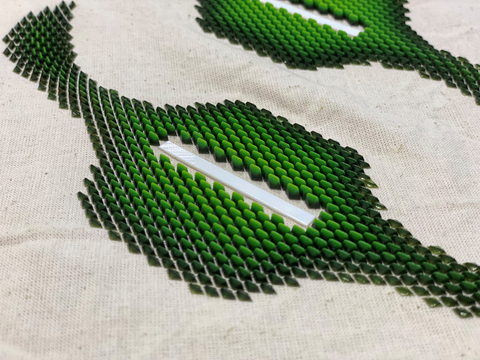New AMGTA Research Shows Environmental Benefits of 3D Material Jetting in Fashion Footwear
According to AMGTA Lifecycle Research, material jetting showed
Collaborative study with Stratasys and Dyloan Bond Factory, a Pattern Group company reveals significant sustainability potential for fashion industry

3D Material jetted logo applique for luxury designer footwear (Photo: AMGTA)
“We are pleased to issue the third body of research in a series of independently commissioned papers designed to reveal the environmental benefits of additive manufacturing adoption. We are committed to advancing the research and publication required to better understand the sustainable value of AM technologies as part of the manufacturing cycle for broad business cases,” said Sherri Monroe, the AMGTA’s Executive Director. “This collaborative study with Stratasys and Dyloan Bond Factory, assessing the impact of a print-to-textile process, is our first research undertaking involving polymer. It delivers important data that supports the value of AM to impact one of the most historically polluting industries in the world.”
Key takeaways from the study include:
-
Reduction in Greenhouse Gas Emissions: The additive manufacturing print-to-textile production process showed a
24.8% reduction in CO2e emissions, when compared with traditional processes. -
Reduction in Material Usage: AM print-to-textile showed a
49.9% reduction of stock material across the supply chain, also reducing and streamlining related transportation needs, and50.0% less material in the resulting 3D printed logo component. - Reduction in Water Usage: The AM process showed a savings of more than 300,000 liters of water across the 16,000 logo components.
-
Reduction in Power Consumption: The additive manufacturing process cut electrical energy consumption by
64% . - Reduction in Supply Chain Dependencies: The shift to AM reduced supply chain dependencies from 4 technologies to 1: with a single additive workflow - and transportation and logistics impacts are eliminated for 3 processes.
The 14-month study analyzed the cradle-to-gate of a 3-dimensional graphic component attached to the heal of a luxury athletic shoe. The AMGTA commissioned the study in 2022 to better understand the potential environmental benefits of additive design and manufacture in an industry that may not be top-of-mind when thinking of additive practices – fashion. The study compared the manufacture of the 3D component through the traditional and additive methods, and was limited in scope to this one component and not the entire shoe. The study evaluated both processes for a production run of 16,000 logo components for 8,000 pairs of shoes and was peer reviewed by ACAM Aachen Center for Additive Manufacturing GmbH.
The traditional multiple-step process includes 2D Inkjet printing and thermal welding of injection molded parts with sheet polyurethane materials. The streamlined additive process included material jetting using photocurable liquid resins with significantly fewer steps. Additional environmental and operational efficiencies were documented related to reduced supply chain dependencies and reduced steps in the production process.
Highlights from the study can be found on the AMGTA’s website. Additional information on this study and others commissioned by the AMGTA can be found on the AMGTA website, www.AMGTA.org.
About the AMGTA
The AMGTA was launched in 2019 to better understand and promote the environmental benefits of additive manufacturing across the global economy. AMGTA members represent the entirety of the manufacturing spectrum - from design and raw materials to end products and users - focused on innovating better, more sustainable, and financially advantageous products through best additive practices. For more information, please contact Sherri Monroe or visit www.AMGTA.org.
View source version on businesswire.com: https://www.businesswire.com/news/home/20231030713690/en/
Sherri Monroe
smonroe@amgta.org
954.308.0888
Source: Additive Manufacturer Green Trade Association







